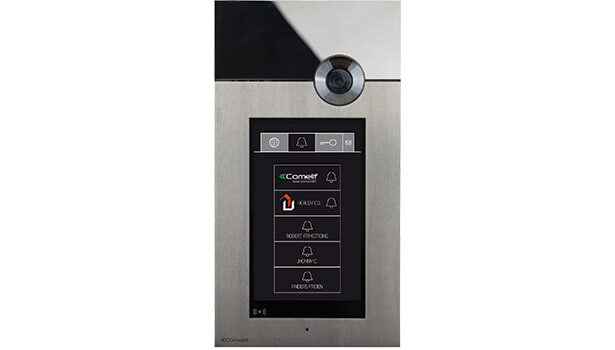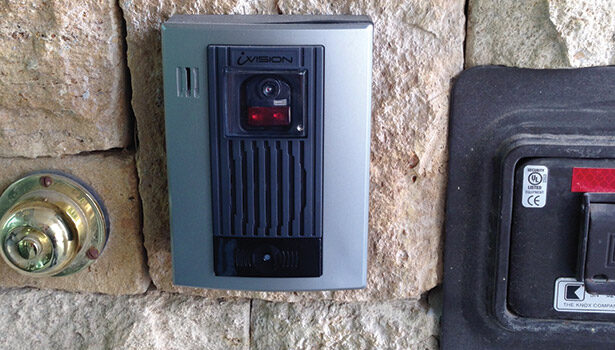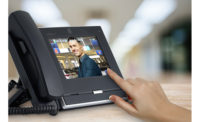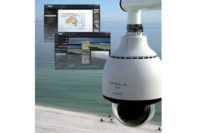It is fair to say the “ayes have it” in intercoms these days — well, make that the “eyes” provided by adding video and the “I” found in Internet protocol-enabled (IP) devices. These are increasing the visibility and mobility that intercom systems allow residential or commercial end users.
Aaron Heiner, COO of integrator Stone Security, Salt Lake City, says that the company, which always has focused on IP-based systems, found it challenging in the past to find intercom solutions that reside on a network. “But those days seem to have passed and over the last few years we have seen several good IP-based intercom options emerge,” he shares.
The IP functionality of intercom systems makes products apt for markets were intercoms may not have worked well or been easy to install in the past.
“As networks become stronger, and components become less expensive, customers are able to utilize IP audio products in places that we never imagined: quick-serve restaurants, parking garages, car dealership monitoring, elementary schools,” says Christopher McNicholas, vice president, sales, Digital Acoustics, Lake Bluff, Ill. “Anywhere you want to centralize management of many intercoms, IP intercoms are a great alternative to analog and POTS-based solutions.”
“The intercom market is adopting IP technology very well,” says John Mosebar, vice president of marketing for Aiphone Corporation, Bellevue, Wash. “Some manufacturers have begun providing integration into SIP technology or VoIP systems, which is a logical approach to offering a total solution including video and more. Aiphone has always been on the forefront of offering intercoms and video together, which is growing more common. These solutions are not to replace CCTV surveillance solutions, but rather bring the capabilities of video front and center,” Mosebar adds.
VISIBILITY
IP is making it easier than ever to enhance intercoms with video, or “eyes,” as Paul Rux, STENTOFON central regional manager, ZENITEL USA, Kansas City, Mo., likes to describe it. And it is an important part of a more secure solution.
“Today’s IP-enabled intercoms with video are easy to deploy and flexible, but more importantly they add ‘eyes’ to intercom and security systems, giving the user better situational awareness, interactivity, and enhanced security and functionality,” Rux says.
Video is quickly growing synonymous with intercoms, as more and more systems have cameras in the intercom stations and connect to multiple cameras around a home or office. Curtis Mayes, installation manager at Atronic Alarms Inc., says that all the intercoms the company has sold recently have been video-enabled.
Paul Williams, vice president of security and communications Products, Control4, Salt Lake City, also reports the company is observing growth in IP-based intercoms that not only include audio, but video as well. “We are seeing this in both the residential and commercial space,” he says. The company has offered video in its intercoms for the last two years, and continues to invest in growing its technology offerings.
Video is the standard in Europe and Asia, but it is only becoming the standard in the bigger markets in the United States such as New York and Los Angeles, observes Patrick Cruz, distribution assistant, Comelit USA, Monrovia, Calif.
“Currently in Boston there is a law that requires any residential apartment that consists of 10 or more units to utilize video intercommunication. Our main focus right now is in fact video intercom, and most of our development in the residential world is in video. Most consumers in the United States are used to video in everyday life, from our smartphones to ATMs to back-up cameras in our cars. It is only natural to be able to see and talk to any visitor at your door before you open it,” Cruz says.
What Is SIP?The Session Initiation Protocol (SIP) is a signaling communications protocol widely used for controlling multimedia communication sessions such as voice and video calls over Internet Protocol (IP) networks. With today’s security intercoms trending toward IP and video options, SIP is more relevant than ever for installers. (Think of it as the communications version of ONVIF or PSIA for video and access control). Henning Schulzrinne and Mark Handley designed the protocol in 1996, and it since has been developed and standardized in RFC 3261 under the oversight of the Internet Engineering Task Force (IETF). “Commercial customers have a strong investment in their SIP-based phone systems from Nortell, Norstar, Cisco, Samsung and Sony, to name a few,” says Paul Rux, STENTOFON, ZENITEL USA. “SIP systems can accept video and audio, while remaining highly vandal-proof, tamper-proof, audibly clear and simple to operate. Clients will ask all the time, ‘Can’t I find an intercom I can simply hang up as a SIP phone on my communication system?’ The answer is ‘Yes.’” SIP is one of two key features that Stone Security looks for in an intercom. “A system’s ability to behave as a SIP device that can integrate into our customers’ phone systems is key,” says Stone Security’s Aaron Heiner. “Nearly every customer we have uses IP-based phone systems that allow for ultimate flexibility in routing intercom calls. Secondly, it must have an integrated IP camera that is supported by major VMS platforms like Milestone. Many IP-based phone systems can also support displaying the video from the intercom’s camera directly on the display of the phone,” Heiner says, adding that this will continue to become more common. |
Intercoms Add Safety to SchoolsThere is a trend toward dealers and integrators working closely with school systems to either install or update intercom systems, according to Keith Daum, director of product marketing for intrusion, fire, communications and hardware, Tri-Ed Distribution, Woodbury, N.Y. “These intercom systems play an overall role in safety and communication for the school. The intercom systems aid in communication between the office and the classrooms for general information or instructions for handling emergency situations,” Daum says. “The video capabilities of an intercom system are becoming more and more instrumental in school safety as well. Having the ability to identify visitors before letting them inside the school is a key attribute to school safety. Some video intercoms also have the ability to integrate with the rest of the CCTV security systems further enhancing the system capabilities,” he adds. |
Some offerings, such as the IS series from Aiphone, which can be hard wired or IP, provide extra capabilities for applications where you need to see more with video. To provide effective security, the company’s IS Series features a wide-angle camera built into the intercom enabling a panoramic view alongside the ability to pan, tilt, and zoom.
The end users that are looking for video are also inquiring — and beginning to expect — interactivity and mobility from intercom systems.
Rux says people frequently ask, “Can I have an IP intercom station where it can come to my iPad, my smartphone, or even skype?”
“The answer is ‘yes’ with today’s technologies,” according to Rux. “Users can view the cameras and interact with the intercom from where they are. IP video intercom and SIP provide people those options today, with the flexibility and instant information they are looking for. People want information now — and video and connected IP services make the system more interactive rather than reactive,” he adds. For more on SIP, read “What is SIP” at left.
Curtis Mayes, installation manager at Atronic Alarms, says the company adds mobility by using the wireless iVision from Optex. “The iVision comes with a handheld wireless receiver (almost like a cordless phone but with a video image on it) that people can carry with them and not be limited to their desk answering the phone. This receiver does not record video, but does record a still image. It is simple to install, very cost effective for the client, and easy to use,” Mayes describes.
Smartphones and computers also can be used to log into the MxDisplay display from network-based security solution provider MOBOTIX, New York. A ringing at the doorbell is forwarded to the smartphone or the workstation. Additionally, the station‘s Wi-Fi Access Point function creates Internet access for the smartphones and computers, which makes it unnecessary to set up an additional Wi-Fi system in the building.
CEM Systems, part of the Security Products business unit of Boca Raton, Fla.-based Tyco, offers a multifunctional touchscreen terminal called Emerald, which the company says “provides more at the door.” Emerald is a touchscreen reader, door controller, VOIP intercom and system terminal all in a single box. The touchscreen LCD “greets” cardholders by illuminating as they approach, providing a user-friendly security experience. Security professionals can use remote apps at the device to update personnel records, book meeting rooms, and even send important messages to cardholders.
Multiple points of control and multiple head-ends are a growing requirement for commercial customers, McNicholas says. “Our enterprise-level software allows for unlimited software-based operator consoles to manage thousands of intercoms, no matter where they are located on the network or across the Internet.”
With the advent of IP-based systems, the possibilities are endless.
“These are open platform systems that get added to your LAN/WAN just like adding a computer to the network,” shares integrator Dennis Gallen, Kintronics Inc., Ossining, N.Y. “You can connect facilities in different states or even countries via IP intercoms. Since our IP intercom systems also utilize SIP protocols, you can add these devices to your network and integrate them into IP phone systems.”
Kintronics, in business since 1977, has been offering video since the late 1990s and soon after that started to add intercoms to the cameras themselves as long as they supported two-way audio. “We have been offering IP- based intercom systems as a stand-alone solution since about 2005,” Gallen recalls. As technology advances, so will the applications, Gallen believes.
More people are surprised that they don’t have to wire intercoms anymore. “They are also surprised by how easy it is to integrate cameras into their SIP systems or security cameras. Additionally, when they purchase IP SIP-based intercoms or video there is an increased return on investment (ROI) of the systems they are so heavily invested in,” ZENITEL’s Rux says.
When you combine a message of security and usability with cameras and interactive features alongside greater ROI from existing systems, you’ll have the attention — and maybe even the “ayes” — for new systems from end users.






